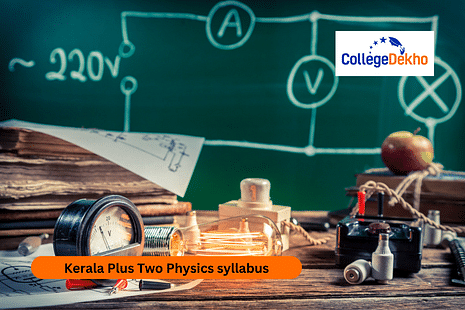

Never Miss an Exam Update
Kerala Plus Two Physics Syllabus 2025: For Kerala Science students, Physics is an important subject. When preparing for the board exams, students can check the Kerala Plus Two Syllabus 2025 on the official website of the Kerala board. The syllabus is divided into 2 parts and is available online in PDF format. In total, 15 chapters need to be studied. The syllabus is designed to provide the most advanced knowledge to students. While going through the chapters, students should also pay attention to the marks distribution. This will help them to figure out the important topics. After going through all the chapters, students can try solving the sample papers and the previous year's question papers.
Physics is a compulsory subject that has a practical and theory exam. The students need to prepare the subject syllabus for the practical exam as it is mandatory to be present for the practical exam. Students can try to score higher marks in practical exams which will improve their overall score. The Kerala Plus Two Board Exams 2025 are going to be conducted in March 2025. Students can check out the detailed
Kerala Plus Two Exam Time Table 2025
. All the important information related to the Physics Syllabus is provided in the article below. Read the article carefully.
Quick Links:
Kerala Plus Two Physics Syllabus 2025: Download PDF
Students can get the link here to download Kerala Plus Two Physics syllabus 2025. Download and save the syllabus PDF to refer to the topipcs in detail.
Kerala Plus Two Physics Syllabus 2025: Course Structure
Kerala Plus Two Physics syllabus is divided into two parts. The table below has the names of all the chapters included in the syllabus. While preparing for the Kerala Plus Two Board exams, students should go through each of the topics. Also, check the marks allotted to each of the topics while preparing the subjects for exams:
Part 1
Chapter Number | Chapter Name |
|---|---|
Chapter 1 | Electric Charges and Fields |
Chapter 2 | Electrostatic Potential and Capacitance |
Chapter 3 | Current Electricity |
Chapter 4 | Moving Charges and Magnetism |
Chapter 5 | Magnetism and Matter |
Chapter 6 | Electromagnetic Induction |
Chapter 7 | Alternating Current |
Chapter 8 | Electromagnetic Waves |
Part 2
Chapter Number | Chapter Name |
|---|---|
Chapter 9 | Ray Optics and Optical Instruments |
Chapter 10 | Wave Optics |
Chapter 11 | Dual Nature of Radiation and Matter |
Chapter 12 | Atoms |
Chapter 13 | Nuclei |
Chapter 14 | Semiconductor Electronics: Materials, Devices and Simple Circuits |
Chapter 15 | Semiconductor Electronics: Materials, Devices and Simple Circuits |
Also Read: Kerala Class 12 Exam Pattern 2025
Kerala Plus Two Physics Deleted Syllabus 2025
The Kerala Plus Two Physics syllabus 2024–2025 has been reduced by the Kerala Board. The curriculum no longer includes topics like electricity, magnetism, electric charges, and many more. To make a study schedule that works, students need to be knowledgeable about the topics.
| Part | Chapter | Topics |
|---|---|---|
| 1 | Chapter 1: Electric Charges and Fields |
|
| Chapter 2: Electrostatic Potential and Capacitance |
| |
| Chapter 3: Current Electricity |
| |
| Chapter 4: Moving Charges and Magnetism |
| |
| Chapter 5: Magnetism and Matter |
| |
| Chapter 6: Electromagnetic Induction |
| |
| Chapter 7: Alternating Current |
| |
| Chapter 8: Electromagnetic Waves |
| |
| Part 2 | Chapter 9: Ray Optics and Optical Instruments |
|
| Chapter 10: Wave Optics |
| |
Chapter 11: Dual Nature Of Radiation and Matter |
| |
| Chapter 12: Atoms |
| |
| Chapter 13: Nuclei |
| |
| Chapter 14: Semiconductor Electronics: Material Devices and Simple Circuits |
|
How To Download Kerala Plus Two Physics Syllabus 2025?
It is an easy process to download the Kerala Plus Two Physics syllabus. The students can visit the official website of the Higher Secondary Education Portal and get the syllabus in the PDF format. They can visit the Directorate of General Education Government of Kerala’s website and follow the step-by-step instructions mentioned below:
- Step 1: Go to the official website of the Directorate of General Education Government of Kerala at dhsekerala.gov.in/
- Step 2: Find the link available for Kerala plus two syllabus 2025 on the homepage. Click on it.
- Step 3: A new page will open with the list of subjects.
- Step 4: Search for the Physics subject and click on download PDF to get the syllabus.
Kerala Plus Two Physics Syllabus Exam Pattern 2025
Students who are getting ready for the Kerala Plus Two board exam need to familiarize themselves with both the syllabus and the exam pattern in detail. The marking scheme, grading scheme, and question types will all be part of the examination structure.Additionally, students will be allowed two hours to complete the paper, which is worth 100 marks. For further information, see the table below:
| Subject | Total Marks | Qualifying score for TE | Overall qualifying score |
| Physics | 100 | 24 | 30 |
Students must complete the syllabus beforehand when preparing for the board exams. To make it easy, they can divide the syllabus into smaller parts. Once the syllabus is completed, students can solve questions from the Kerala Plus Two Model Question Papers . The questions make students familiar with the types of questions asked in the board exams. Regular practice helps students to improve their skills to write answers and fetch good marks.
Was this article helpful?
















